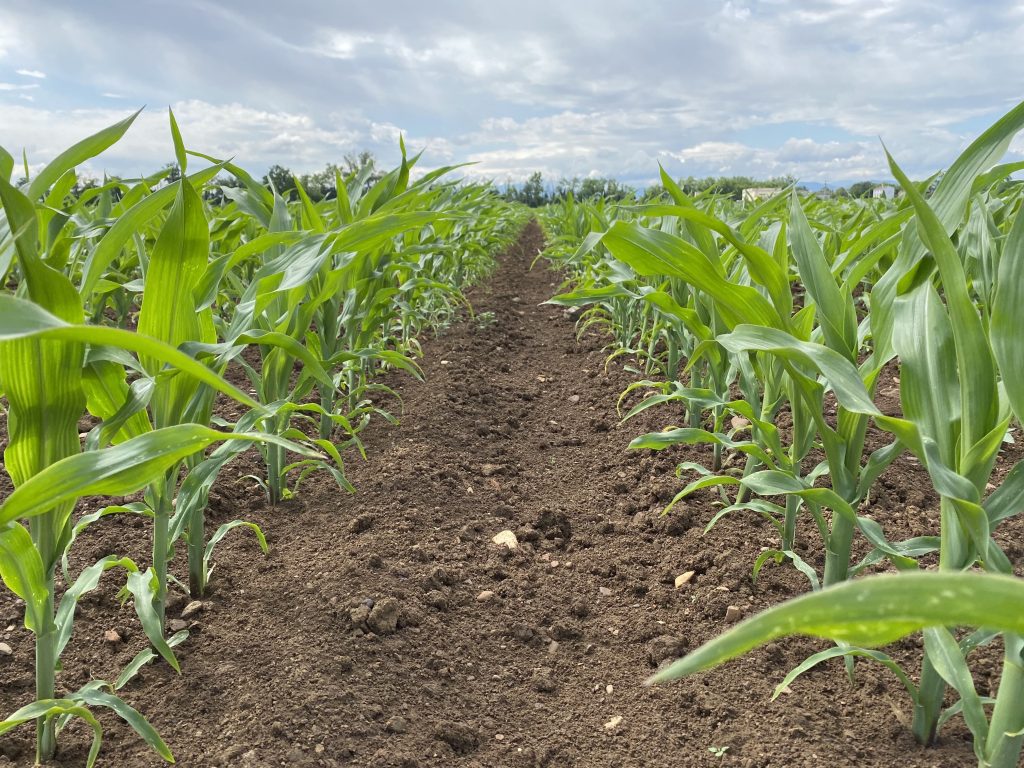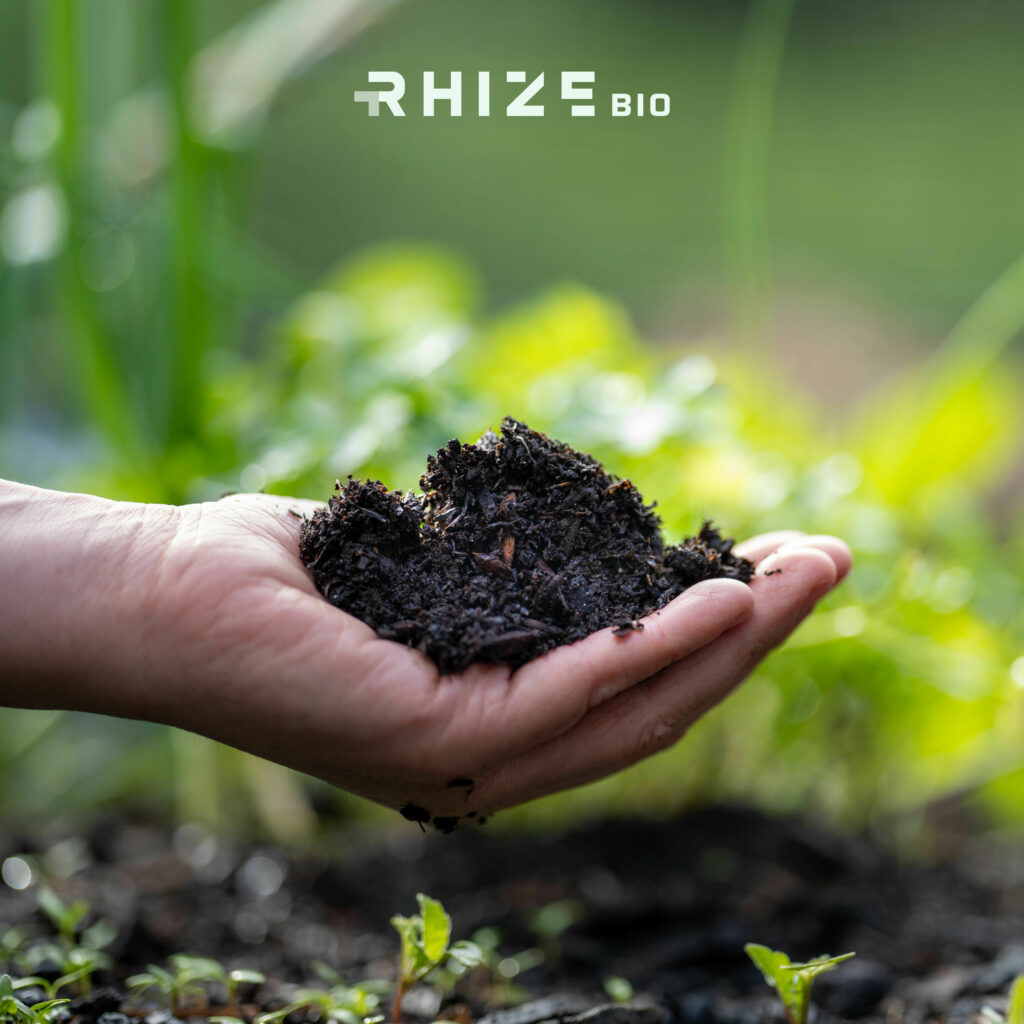As we delve into the fascinating world of agriculture, a fundamental question arises: what lies beneath the surface of our fields, driving the health and productivity of our crops? The answer unveils a remarkable relationship between microbes and soil health, a synergy that forms the cornerstone of sustainable farming practices. At RhizeBio, we’re dedicated to unraveling the mysteries of this hidden realm and harnessing its potential to revolutionize agriculture. Join us into the microscopic world beneath our feet, where we’ll explore the critical role of microbes in boosting crop production and delve into why measuring these microbial communities is essential for sustainable farming.

Unmasking Microbial Allies
Beneath the surface of every field lies a hidden world, teeming with life and activity. It’s a world dominated not by towering plants or scurrying animals, but by microbes – tiny organisms that wield incredible power in shaping the health and vitality of the soil. In our journey to unmask these microbial allies, we peel back the layers of earth to reveal a bustling ecosystem of microscopic activity.
Microbes, though invisible to the naked eye, are the unsung heroes of soil health. They form a diverse community that includes bacteria, fungi, protozoa, and other microorganisms, each playing a unique role in the soil ecosystem. These tiny organisms are involved in a multitude of processes critical to plant growth and nutrition.
One of the key roles of soil microbes is nutrient cycling. They break down organic matter, such as dead plant material and animal remains, into simpler compounds that plants can absorb and use for growth. This process releases essential nutrients like nitrogen, phosphorus, and potassium back into the soil, creating a nutrient-rich environment for plants to thrive.
Microbes also play a crucial role in soil structure. Fungi, for example, form intricate networks of hyphae that bind soil particles together, creating stable soil aggregates that improve soil structure and water retention. Bacteria produce sticky substances that help hold soil particles together, preventing erosion and promoting soil stability.
But perhaps the most remarkable aspect of soil microbes is their ability to form symbiotic relationships with plants. Certain species of bacteria and fungi, known as mycorrhizae, form partnerships with plant roots, exchanging nutrients and water in exchange for carbohydrates produced by the plants through photosynthesis. These symbiotic relationships boost plant growth and help plants adapt to environmental stresses such as drought and nutrient deficiency.
In essence, soil microbes are the architects of a healthy soil ecosystem, laying the foundation for robust plant growth and abundant harvests. By understanding and harnessing the power of these microbial allies, farmers can unlock the full potential of their soil and cultivate thriving agricultural landscapes for generations to come.
Microbial Contributions to Soil Health
The contributions of soil microbes to soil health are both diverse and profound. These tiny organisms, invisible to the naked eye, play a multitude of roles that are essential for maintaining the fertility and productivity of the soil.
At the most basic level, soil microbes are responsible for the decomposition of organic matter. When plants and animals die, their remains are broken down by a vast array of microorganisms, including bacteria, fungi, and other decomposers. This process releases nutrients such as nitrogen, phosphorus, and potassium back into the soil, where they can be taken up by plants and used for growth.
In addition to breaking down organic matter, soil microbes also play a crucial role in nutrient cycling. Certain species of bacteria are capable of fixing atmospheric nitrogen, converting it into a form that plants can use. Other microbes are involved in the cycling of phosphorus, sulfur, and other essential nutrients, ensuring that they remain available to plants in the soil.
But perhaps the most important role of soil microbes is their ability to form symbiotic relationships with plants. Certain species of fungi, known as mycorrhizae, form associations with plant roots, extending their reach into the soil and helping plants access water and nutrients. In exchange, the plants provide the fungi with carbohydrates produced through photosynthesis, creating a mutually beneficial relationship that enhances plant growth and productivity.
In addition to their roles in nutrient cycling and plant symbiosis, soil microbes also contribute to soil structure and aggregation. Fungi, in particular, produce a network of thread-like structures called hyphae, which bind soil particles together and create stable soil aggregates. These aggregates improve soil structure, increase water infiltration, and reduce erosion, creating a more hospitable environment for plant roots to grow and thrive.
In summary, soil microbes are essential for maintaining soil health and fertility. Their roles in decomposition, nutrient cycling, plant symbiosis, and soil aggregation are all critical for supporting healthy plant growth and sustainable agriculture. By understanding and harnessing the power of these tiny organisms, farmers can improve soil health, increase crop yields, and promote long-term sustainability in their fields.

Why Measure Microbes in Your Soil?
Measuring microbes in your soil is not just an academic exercise – it’s a practical necessity for anyone serious about sustainable agriculture. Soil microbes play a crucial role in soil health and fertility, and understanding their abundance and diversity can provide valuable insights into the condition of your soil and the effectiveness of your farming practices.
One of the primary reasons to measure microbes in your soil is to assess soil fertility. Soil microbes are responsible for breaking down organic matter and releasing nutrients such as nitrogen, phosphorus, and potassium back into the soil, where they can be taken up by plants. By measuring microbial activity, farmers can get a better understanding of the nutrient cycling processes happening in their soil and make informed decisions about fertilizer applications and soil amendments.
Measuring microbes can also provide insights into soil structure and aggregation. Certain groups of microbes, such as fungi, play a key role in creating stable soil aggregates that improve soil structure and water infiltration. By quantifying the abundance of these microbes, farmers can assess the health of their soil and identify opportunities to improve soil structure through practices such as cover cropping and reduced tillage.
In addition to assessing soil fertility and structure, measuring microbes can also help farmers monitor soil health and detect changes over time. Certain groups of microbes are sensitive to environmental factors such as temperature, moisture, and pH, so changes in their abundance or diversity can indicate shifts in soil conditions. By regularly monitoring microbial populations, farmers can identify potential problems early and take corrective action before they impact crop yields.
Finally, measuring microbes in your soil can help you evaluate the effectiveness of different agricultural practices and management strategies. By comparing microbial populations in different fields or treatment plots, farmers can determine which practices are most beneficial for soil health and productivity. This information can guide future decision-making and help farmers optimize their farming systems for maximum sustainability and profitability.
In conclusion, measuring microbes in your soil is essential for understanding soil health and fertility, assessing the effectiveness of farming practices, and making informed decisions about soil management. By quantifying microbial populations and monitoring changes over time, farmers can improve soil health, increase crop yields, and promote long-term sustainability in their fields.
Technology and Microbial Insights
Advancements in technology have revolutionized our ability to study soil microbes and gain insights into soil health and fertility. Through techniques such as shotgun metagenomics and high-throughput DNA sequencing, scientists can now analyze the DNA of entire microbial communities in soil, providing a comprehensive view of microbial diversity and abundance.
Shotgun metagenomics involves sequencing the DNA of all microorganisms present in a soil sample, without the need for culturing or isolation. This approach allows researchers to identify thousands of different microbial species in a single sample, providing a detailed picture of soil microbial communities and their functions. By analyzing the DNA sequences of these microbes, scientists can gain insights into their identities, abundances, and metabolic capabilities, helping to unravel the complex interactions that drive soil ecosystems.
In addition to shotgun metagenomics, machine learning algorithms are also being used to analyze soil microbial data and identify patterns that are not visible to the naked eye. These algorithms can process large volumes of data and detect subtle relationships between microbial populations and environmental variables, such as soil moisture, temperature, and pH. By uncovering these relationships, scientists can gain a deeper understanding of how soil microbes respond to changes in their environment and how they influence soil health and fertility.
By combining advanced technologies with traditional microbiological techniques, scientists can gain valuable insights into soil health and fertility that were previously inaccessible. These insights can help farmers make informed decisions about soil management practices, such as fertilizer applications, crop rotations, and tillage methods, leading to improved soil health, increased crop yields, and enhanced sustainability in agricultural systems.
In conclusion, technology has revolutionized our ability to study soil microbes and gain insights into soil health and fertility. Through techniques such as shotgun metagenomics and machine learning, scientists can analyze microbial communities in soil and uncover complex relationships between microbes, plants, and the environment. By leveraging these technologies, farmers can optimize soil management practices and promote long-term sustainability in their fields.

Elevating Agriculture with Microbial Wisdom
By harnessing the wisdom of soil microbes, we can elevate agriculture to new levels of productivity, sustainability, and resilience. Soil microbes play a crucial role in maintaining soil health and fertility, and by understanding and optimizing their activities, farmers can improve crop yields, reduce input costs, and promote long-term sustainability in their fields.
One of the key ways that soil microbes contribute to agricultural productivity is through their roles in nutrient cycling and plant symbiosis. Certain groups of microbes, such as nitrogen-fixing bacteria and mycorrhizal fungi, play essential roles in supplying plants with essential nutrients such as nitrogen, phosphorus, and potassium. By promoting the activities of these beneficial microbes, farmers can reduce their reliance on synthetic fertilizers and improve the efficiency of nutrient use in their fields.
In addition to nutrient cycling, soil microbes also play a crucial role in soil structure and aggregation. Fungi, in particular, produce a network of thread-like structures called hyphae, which bind soil particles together and create stable soil aggregates. These aggregates improve soil structure, increase water infiltration, and reduce erosion, creating a more hospitable environment for plant roots to grow and thrive.
But perhaps the most important role of soil microbes is their ability to enhance plant resilience to environmental stresses. Certain groups of microbes produce compounds that stimulate plant growth and increase tolerance to drought, disease, and pests. By promoting the activities of these beneficial microbes, farmers can help their crops withstand environmental stresses and achieve higher yields in challenging conditions.
By understanding and harnessing the power of soil microbes, farmers can unlock the full potential of their soil and cultivate thriving agricultural landscapes for generations to come. By optimizing soil health, promoting nutrient cycling, and enhancing plant resilience, we can create a more sustainable and resilient food system that nourishes both people and the planet.
Ready to uncover your soil’s microbial secrets? Partner with us for in-depth insights into microbial communities. Contact us today and embark on a journey where microbes become allies in cultivating a resilient, nutrient-rich agricultural future. Experience sustainable farming practices firsthand.
